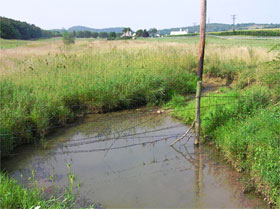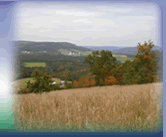CONSERVATION PRACTICE 29 ~
MARGINAL PASTURELAND WILDLIFE HABITAT
Printable PDF File of Conservation Practice 29 (CP 29)
(Brochure will open in new window)
| Description: |
Guidelines: |
| CP 29, marginal pastureland wildlife habitat, is designed to naturally re-establish a vegetated riparian buffer along stream corridors impacted by agricultural practices and livestock grazing. Streambank crossings (when necessary), fencing to exclude livestock, as well as watering systems are provided with this conservation practice. |
Buffer must be a minimum width of 35 feet and a maximum average width of 180 feet. Buffer must have a minimum width of 50 feet to receive 100% cost share. Buffer does not require tree planting, but must be managed to control invasive species propagation. |
 What is Marginal Pastureland? What is Marginal Pastureland?
Streamside areas not presently covered with trees and other woody plant species. These areas may or may not currently have livestock grazing on them. |
| Eligibility: |
Conservation Practice Responsibilities: |
| Any land in agricultural production within 180 feet of a stream, which is not designated as cropland and is not forestland can be enrolled in CP 29. A landowner or farm operator must have owned or managed the land for more than one year before enrolling. |
The fence must be maintained for the length of the contract. Noxious weeds must be controlled through mowing or herbicide application. The first 35 feet of the buffer cannot be mowed. |
| Conservation Benefits: |
Additional Benefits: |
- Protection of permanent and seasonal streams
- Reduction of nutrient, sediment, pesticides, organic matter and other pollutant entry to waterways
- Creation of stream shading to lower water temperature
- Restoration of wildlife & fish habitat
|
- Stabilized livestock stream crossings
- Livestock watering systems
- Reduction in field erosion and soil loss
- Financial savings on marginally productive areas
- Reduction in livestock ailments, such as mastitis and hoof problems
|
Possible Wildlife Attracted to CP 29 Marginal Pastureland Wildlife Habitat
For the wildlife enthusiast, the habitat established by CP 29 is utilized by a variety of animal and insect species throughout the seasons. Mammals and birds will use the riparian areas for feeding, cover, and nesting purposes. Many desirable insects will use the areas as a hub for activities during the warmer months. Landowners who have CP 29 established on their property can look forward to the increase of wildlife seen in the area!
$$$$$$$$$$$ Funding, Reimbursements, and Rental Payments $$$$$$$$$$
By installing a buffer through CREP you will receive 50% reimbursement for practice establishment (cost share), annual rental and maintenance payments, and incentive payments from the USDA Farm Service Agency (USDA FSA). If the buffer is 50 feet wide or larger, you will receive an additional 50% cost share from the Pennsylvania Department of Environmental Protection (DEP) through the Pennsylvania Association of Conservation Districts (PACD).
- Rental Payment: Calculated by multiplying the Average Base Soil Rental Rate x 250%.
- Cost Share: (for DEP cost share, buffer must be a minimum of 50 feet wide and contain livestock fencing)
- 50% from USDA FSA
- 50% ($400 per acre maximum with fence; no cost share without fence) from DEP
- Practice Incentive Payment (PIP): 40% of eligible practice installation costs
- Signup Incentive Payment (SIP): $10 per acre x number of contract years (10 or 15 year enrollment option)
- Annual Maintenance Payments: $7 to $10 per acre per year
A landowner enrolling in CP 29 is responsible for the up-front costs of installing the practice and contacting a contractor to install a stream buffer, so be sure and tell your contractor that they are installing a CREP buffer.
Technical Assistance Available for CREP CP 29 Marginal Pastureland Wildlife Habitat
What to do first: Call your local USDA Farm Service Agency or Natural Resources Conservation Service office. Tell them you are interested in installing a buffer on your land through CREP, then ask them for more information about the benefits of buffers on your land!
Page updated on:
July 10, 2006
|



